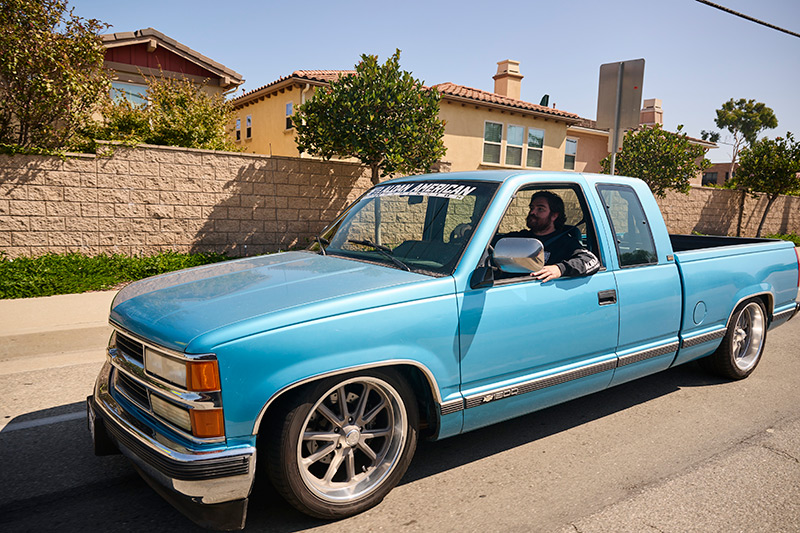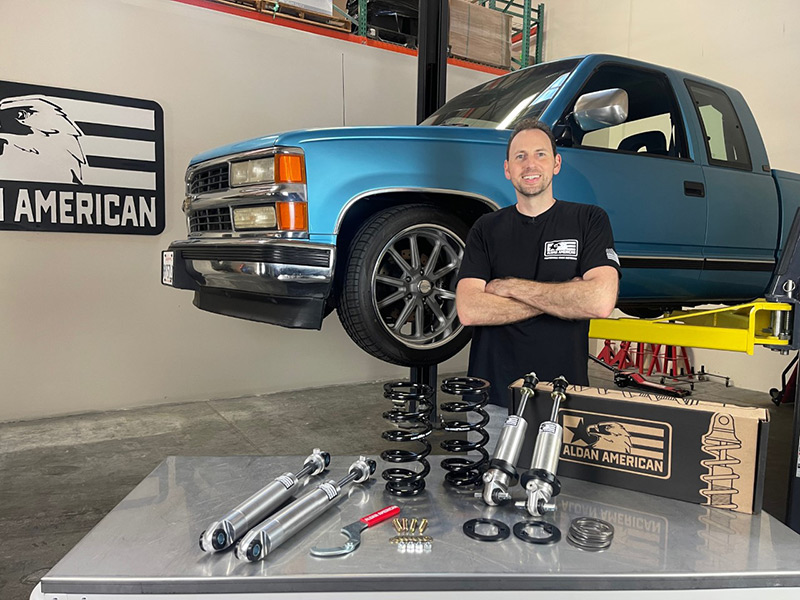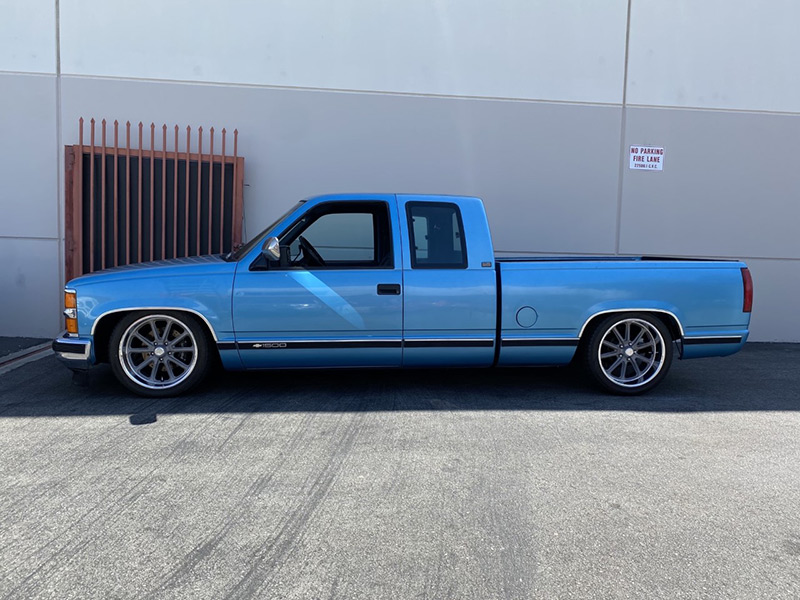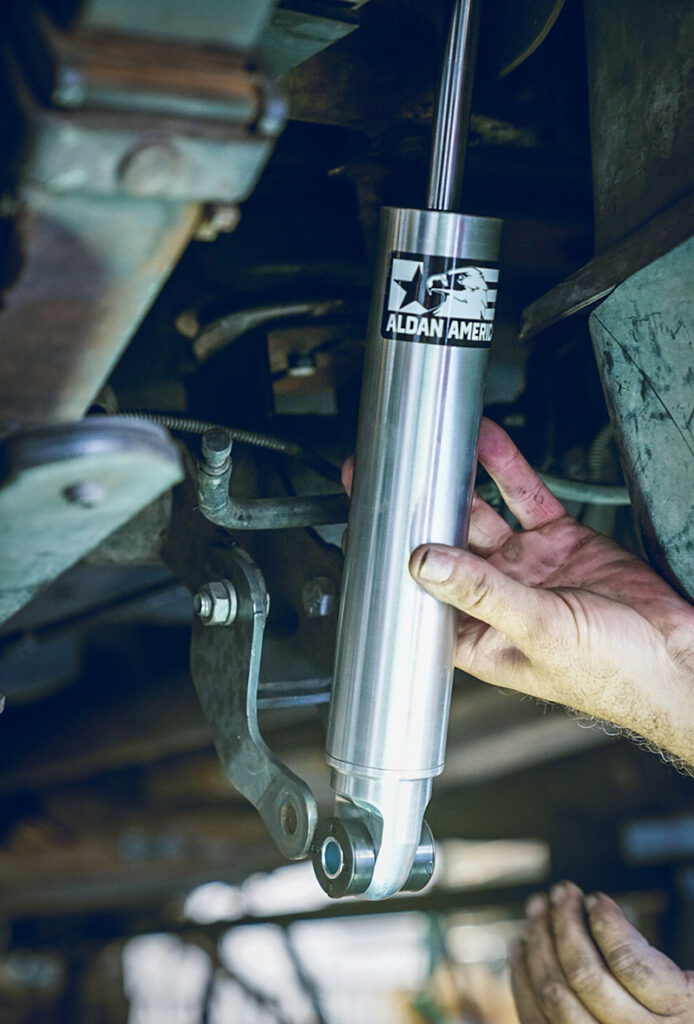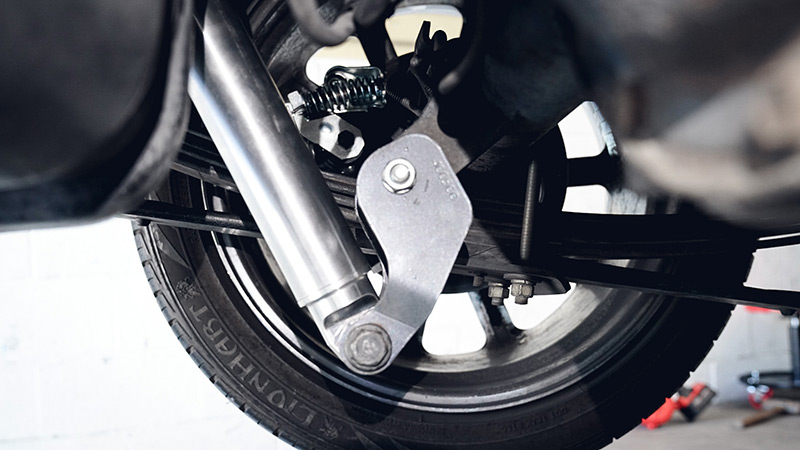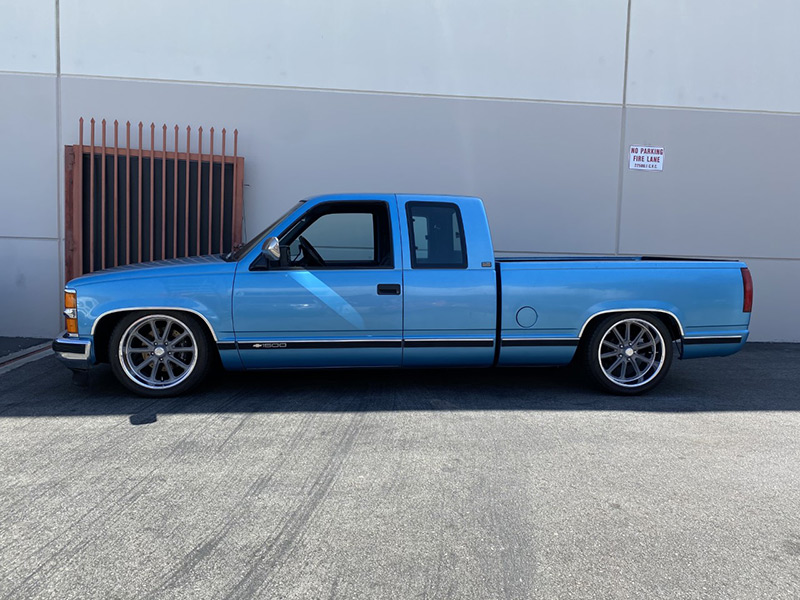Transforming a Classic: Performance Upgrades for the Fourth-Generation Chevrolet C1500
Introduction
In 1988, Chevrolet made a profound impact with its fourth-generation RWD pickup truck model, the C1500, also known as the OBS (Old Body Style). Renowned for their robust build and enduring popularity, these trucks symbolize strength, reliability and versatility. And the OBS is a fantastic platform for performance improvements.
The fourth-generation C1500, a significant step forward from its predecessor, brought notable improvements in performance, comfort, and technology. Its design, balancing traditional ruggedness with modern refinements, catered to various needs, from hauling heavy loads to daily commuting.
This comprehensive guide is dedicated to Chevy C1500 owners who seek to enhance their vehicles. When looking to boost performance, aftermarket upgrades offer endless possibilities.
Here, we delve into the most popular and effective modifications for the fourth-generation C1500 for street, strip or autocross. We’ll cover a range of performance parts that unleash the truck’s true potential and provide a roadmap for transforming your OBS into a more capable, personalized, and enjoyable machine.
Let’s explore the best aftermarket upgrades that will take your Chevy C1500 experience to the next level in performance.
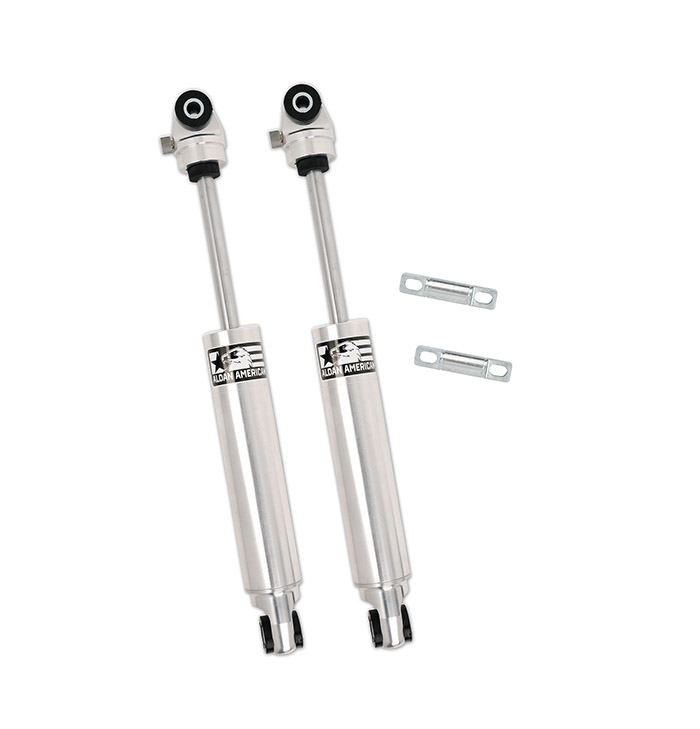
Design and Development
In developing the fourth-generation Chevrolet C1500, Chevrolet engineers and designers were focused on enhancing functionality and appeal. They shifted the design towards a more aerodynamic and contemporary exterior, moving away from the boxier shapes of previous generations. This change aimed to improve fuel efficiency and reduce wind noise.
Inside, the team designed a more ergonomic and comfortable cabin, acknowledging the growing trend of using pickup trucks as daily drivers, not just work vehicles. The OBS provided powertrain options and suspension systems that offer better handling, increased towing capacity, and enhanced overall performance.
C1500 Upgrade Potential
In our dive into the design and development of the fourth-generation Chevrolet C1500, it’s clear this truck was a game-changer. The design and configurations of the C1500 make it an ideal candidate for any number of performance upgrades. Now, let’s explore the various specifications that make the C1500 a standout model in Chevrolet’s lineup and a prime choice for customization.
Under the hood, the C1500 has several engine options configured to cater to diverse needs, from the efficient 4.3 L Vortec V6 up to the powerful 7.4 L V8. Coupled with these engines were transmission systems, including smooth-shifting automatics to robust manual transmissions.
Moving to the truck’s body, Chevrolet offered four cabs and two different bed lengths, each serving different purposes and preferences. There was a configuration for every need, from regular cabs suited for traditionalists to extended and crew cabs offering more passenger space. Similarly, the beds varied in size, from shorter versions for easier maneuverability to longer beds for maximum hauling capacity.
Lastly, the C1500 was available in several models, each with unique features and trim levels. These ranged from the workhorse base models to the more luxurious trims like the Scottsdale and Silverado with advanced features and comforts. This range ensured that whether buyers were looking for a no-frills work truck or a more comfortable, feature-rich vehicle, the C1500 lineup had something to offer.
The fourth-generation Chevrolet C1500 was not just a giant move forward. Its engine options, transmissions, available rear axle ratios, and various cabs, beds, and models made it a versatile and adaptable truck capable of meeting multiple needs and preferences. The inherent design strengths of the C1500 provide a solid foundation for a wide range of aftermarket upgrades to enhance performance.

C1500 Suspension Upgrades
Overview of Suspension Systems in the Chevy C1500
The suspension system in any truck plays a crucial role in determining the vehicle’s handling, ride quality, and load-carrying capabilities. Like its predecessor, the fourth generation employed a combination of front-independent and rear-leaf spring suspensions. This setup balanced comfort and utility, ensuring the truck could easily handle daily driving and hauling heavier loads.
Engineers changed the suspension geometry in the fourth-generation Chevrolet C1500 pickup truck compared to the third-generation models. These changes were part of the overhaul to improve ride quality, handling, and overall performance.
The suspension geometry redesign focused on several key areas:
Wheel Alignment and Stance: Adjustments were made to the wheel alignment settings and the truck’s stance, which included changes to camber, caster, and toe angles, which helped achieve better tire contact with the road, improving traction and stability.
Suspension Angles and Linkages: The angles and linkages of the suspension components were modified, which involved reconfiguring the positioning of the control arms, springs, and shock absorbers to optimize the truck’s handling characteristics and reduce body roll during cornering.
Steering Response: Modifications in the suspension geometry contributed to a more direct and responsive steering feel. This made the truck more agile and maneuverable, especially at higher speeds or during towing.
Suspension and Steering Upgrades
Springs and Shock Absorbers
Upgrading to performance-oriented shock absorbers is a common step for C1500 owners looking to improve ride quality and handling. Aldan American’s front coilover and rear shock absorbers, designed for the C1500, enhance damping control and stability, especially in demanding driving conditions.
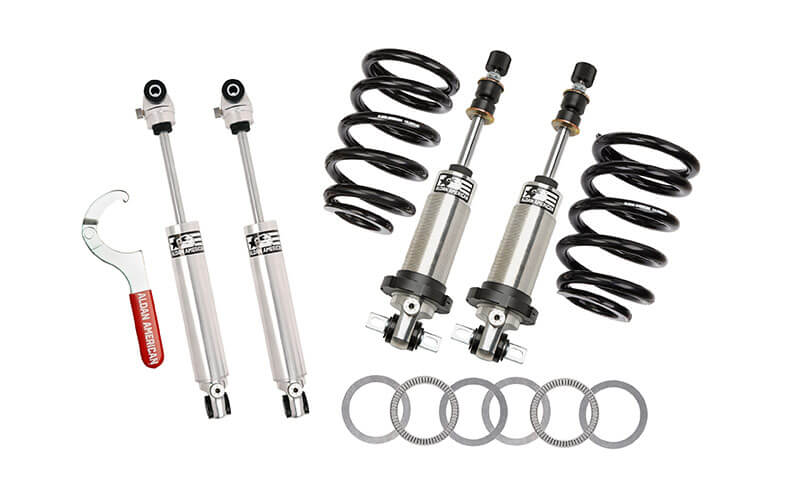
Lowering Kits
Fourth-generation Chevrolet C1500 owners can significantly enhance their vehicle’s stance and performance by installing a Western Chassis lowering kit. Western Chassis, known for its high-quality suspension components, designs these drop spindles specifically to lower the C1500 from 2″/4″ to 3″/5″ and up to 4″/6″.
This modification improves not only the truck’s appearance but also its handling without compromising the original suspension geometry, unlike other methods of lowering. Adding adjustable and robust Aldan American shocks sharpens the handling and stability while contributing to a sportier, more aggressive look.
Control Arms
Several companies manufacture upgraded tubular control arms for the OBS trucks. Our favorite is the narrow control arms from Stone Custom Fabrication. These arms are available for the stock spring setup or a coilover conversion. They’re narrowed 3″ from stock and accommodate up to 26″ wheels.
Sway Bars
Our resident OBS expert recommends fitting the Universal Antirock Kits (sway bars or anti-roll bars, if you prefer) from RockJock. The bars are splined, just like on race cars, with a choice of aluminum or steel arms. The end links are adjustable to dial in the response you prefer.
Traction Bars
Before jumping headlong into a four-link conversion, installing a traction bar system from Western Chassis for lighter duty could be a lower-cost solution. The Cal-Trac Traction Bars resists axle wrap while maintaining the pinion angle and can lower 60 feet times.
Four Link Rear Suspension
Short of an IRS conversion, a four-link rear axle setup is your best solution for optimum handling and grip. The links located the axle more accurately and better resists the twisting forces generated through engine power delivery to the differential. Four-link rear suspension systems also replace the leaf springs with modern coilover springs and shocks. Scotts Hot Rods is an excellent source for four link kits and technical advice and is well known for the quality of its fabricated parts.
Steering Upgrades
To improve steering with a modern feel, consider the Borgeson quick ratio (12.7:1) power steering box to replace the Delphi 800 OEM series on your OBS. It bolts directly to the stock location and fits with the OEM pitman arm, steering shaft and hoses.
For ultimate steering upgrades, check out the power rack and pinion conversion kit from Elevated Concepts, which bolts in and requires no additional modifications besides minor spindle drilling.
Installation Tips and Considerations
Owners can choose between DIY and professional services when it comes to installation. Installing suspension components can be complex and requires a certain level of mechanical skill and tools. We recommend professional installation for those uncomfortable with DIY installations to ensure safety and proper performance.
Owners should also consider the ongoing maintenance of these components, as regular checks and adjustments may be necessary to maintain optimal performance and safety. Manufacturers typically call out any required maintenance in their installation instructions.
Engine Performance Basics
Chevrolet launched its fourth-generation pickup truck with a lineup of powerful engines (for the time), each designed to cater to different needs and preferences. The base engine, a 4.3-liter V6, offered a respectable balance of power and efficiency, delivering 160 horsepower and 235 lb-ft of torque.
Chevrolet also offered its 5.0-liter V8 engine, producing 175 horsepower and 275 lb-ft of torque, and the 5.7-liter V8 that churned out 210 horsepower and 300 lb-ft of torque.
A significant advancement came with the introduction the Vortec series in the mid-1990s, which included updated versions of the 5.0-liter and 5.7-liter V8 engines. The Vortec 5000, a 5.0-liter V8, offered improved performance with 230 horsepower and 285 lb-ft of torque. The Vortec 5700, a 5.7-liter V8, was even more impressive, delivering 255 horsepower and 330 lb-ft of torque.
Additionally, by 1998, the lineup included a 6.5-liter turbo-diesel engine, which provided exceptional towing capabilities and efficiency for long hauls, producing about 180 horsepower and a substantial 360 lb-ft of torque.
When it comes to enhancing the performance of the fourth-generation Chevrolet C1500, understanding the basics of engine components and performance metrics is crucial. The engine’s performance is determined by its ability to efficiently mix air and fuel, ignite the mixture, and expel exhaust gases.
First Step Performance Upgrades
Cold Air Intakes
Upgrading the air intake system is among the most popular and effective ways to boost engine performance. A high-quality air intake system increases the flow of cooler, denser air into the engine, improving combustion efficiency and increasing power.
One example is the K&N Filters 57-3013-2 Performance Air Intake System, which, when installed on a 1996 Chevrolet C1500, freed up nearly 9.5 horsepower.
There are additional opportunities to improve gas flow within the engine, which we’ll get to shortly.
Exhaust Systems
For exhaust systems, upgrades often involve installing wider pipes and more efficient mufflers, which reduce backpressure and allow exhaust gases to exit more freely, enhancing engine performance. Systems like Flowmaster American Thunder and MagnaFlow Street Series are cat-back exhaust systems that improve performance and add a distinct sound to the vehicle.
To truly optimize airflow through the exhaust system, consider two other components:
Exhaust Headers
A properly designed set of headers improves outbound gas flow and is more efficient than the cast iron OEM manifold. With high-flow exhaust headers, spent combustion gases flow more efficiently out of the combustion chamber, allowing a fresh fuel/air mixture to enter the cylinder more quickly, improving combustion and power. Schoenfeld, highly regarded for their headers, offers a range of headers for the OBS, including headers for those installing an LS engine.
High Flow Catalytic Converter
To remove all possible restrictions, you can replace your restrictive OEM catalytic converter with high-flow performance units from Flowmaster, DynoMax and MagnaFlow, all available online through Jeg’s online store.
Engine Tuning: Chips, Programmers, and Tuning Options
Engine tuning involves adjusting the electronic control unit (ECU) settings to improve performance, which can be achieved through performance chips or programmers like those offered by Black Bear Performance. Black Bear offers their Traditional Tune plus two higher levels, which are programmed based on vehicle modifications and use. These devices modify parameters such as fuel delivery and ignition timing, increasing power and, in some cases, improving fuel efficiency.
Key Engine Upgrades
We like what member PlaywithTBI wrote on the GM Truck Club board about SBC-powered C1500s. In addition to the exhaust systems modification listed above, he suggests a high-flow throttle body with an Edelbrock 3704 intake manifold.
Diving deeper into the engine, this contributor suggested high-flowing 62cc Summit Racing 162108 aluminum heads with hardened push rods, which can all be installed without removing the engine. A further step suggested is a more performance-oriented camshaft. There’s an entire range available here, where at least one will match your needs.
Superchargers and Turbochargers
For those seeking a significant boost in power, installing a supercharger or turbocharger – collectively known as forced induction systems – is a viable option. These systems compress the air entering the engine, forcing more oxygen into the combustion chamber, which significantly increases power output. Recommended kits for the C1500 include those from Whipple Superchargers or Stark Fabworks, known for their reliability and performance gains.
LS Engine Swap
If you have a big enough budget, an LS7 or LS9 swap would make your C1500 an insane performer, though reality quickly sets in. We like the recommendation of All Chevy Performance magazine for a budget option. They like the LS3 from the C6 Corvette and Gen 5 Camaro as a lower-cost alternative. If the out-of-box 430 horsepower isn’t enough for you, some simple upgrades can send output over 500 HP. Installation is made simple with a complete package from Speed Engineering that includes all components needed for the swap, down to the dipstick.
Cooling Systems
With increased engine performance comes the need for better cooling. Upgraded radiators and cooling components are essential to maintain optimal engine temperatures and prevent overheating, especially in high-performance or heavy-duty applications. Products from companies like Cold-Case provide enhanced cooling capabilities, ensuring the engine runs efficiently under increased stress.
Safety and Compliance
Engine modifications can dramatically enhance the performance of the Chevrolet C1500. However, balancing these improvements with safety and legal compliance is essential for a rewarding and responsible upgrade experience.
Key Drivetrain Upgrades
Transmission Upgrades: Enhancing Durability and Performance
Upgrading the transmission is pivotal for handling increased power from engine modifications and ensuring smoother power delivery. Enhancements can include heavy-duty gear sets, shift kits, and upgraded torque converters. These modifications can improve gear shifting, increase durability under high-stress conditions, and provide a more responsive driving experience.
Automatic Transmission
Are you seeking expert advice on upgrading the 4L60E automatic in your C1500? We like the advice offered by Gearstar Performance. Their posted article covers 16 tips on improving the durability and performance of the automatic, which you can read here. You can also purchase 4L60E upgraded units from Monster Transmission or B&M Transmissions.
Differential Upgrades: Types and Benefits for Different Driving Conditions
The differential is crucial in allowing the wheels to rotate at different speeds, particularly important when turning. Upgrading the differential can improve traction, handling, and the truck’s ability to effectively transmit power to the ground. Options include limited-slip and locking differentials from manufacturers like Powertrax, Yukon and Hurst, all available through Summit Racing.
Axles and Drive Shafts: Strengthening for Performance and Durability
Strengthening the axles and drive shafts is essential, especially in a high-performance or heavy-duty C1500. Upgraded axles and drive shafts can handle increased torque and power, reduce the risk of breakage, and improve overall durability. You can purchase the parts separately and assemble them yourself or turn to Moser Engineering for a built-to-order 12-bolt assembly.
Tires and Wheels
For the fourth-generation OBS (Old Body Style) Chevrolet C1500, various tire and wheel upgrades can enhance the truck’s appearance and performance. These upgrades can range from changing the tire size for better traction and handling to more comprehensive changes involving new rims and high-performance tires.
Larger Diameter Wheels: Upgrading to larger diameter wheels is a popular modification. We prefer wheels from Hot Rods by Boyd, who offer modern wheel designs and ’90s-style wheels if you’re going for an OBS with a retro vibe.
Wider, Low Profile Tires: Installing wider tires can increase the contact patch with the road, improving traction and stability, which is especially useful for towing or hauling.
Upgraded Wheel Bearings and Hubs: For those with significantly larger or heavier wheels and tires, upgrading the wheel bearings and hubs can be a good idea to handle the extra stress. Check out this front hub upgrade kit from Camburg.
Ensuring that any tire and wheel upgrades are compatible with the C1500’s specifications is crucial. Changes to wheel and tire sizes can affect the vehicle’s handling, speedometer calibration, and even the transmission shift patterns.
Wheel Alignment
Proper wheel alignment, including the OBS (Old Body Style) Chevrolet C1500 pickup truck, is crucial for any vehicle. Correct alignment ensures optimal handling, tire longevity, and fuel efficiency. Here are some tips and advice for wheel alignment on an OBS C1500:
For the OBS C1500, it’s essential to know the specific alignment specifications, which include camber, caster, and toe settings. These specifications can vary depending on the year of your truck and any modifications you’ve made, such as aftermarket suspension components.
Camber Adjustment: Camber is the angle of the tire relative to the road when viewed from the front of the vehicle. Increased camber improves handling and response but can cause uneven tire wear.
Caster Adjustment: Caster is the angle drawn through the upper and lower steering pivot points. Proper caster ensures straight-line stability and impacts the steering feel. OBS trucks usually benefit from a more positive caster setting for better highway stability.
Toe Adjustment: Refers to how much the tires turn inward or outward when viewed from above. More aggressive toe settings can improve turn-in on track or at an autocross. They can also lead to rapid tire wear on the street.
Remember, a well-aligned truck not only drives better but also saves you money in the long run by preventing premature tire wear and improving fuel economy.
Braking System Upgrades
For fourth-generation Chevrolet C1500 trucks, upgrading the brake system is vital for owners looking to enhance safety and performance, especially those trucks with upgraded, more powerful engines. A variety of brake upgrades are available, each designed to provide better stopping power and improved handling.
A rear brake drum-to-disc conversion combined with OEM front rotors can improve C1500 braking by enhancing its performance and reliability. POL’s conversion kit replaces the traditional drum brakes with more efficient and responsive disc brakes, offering improved heat dissipation and reduced stopping distances, especially critical in heavy towing and hauling situations.
A popular upgrade is the installation of a big four-wheel brake kit. Wilwood front and rear brake kits include oversized rotors, larger calipers with more pistons, and high-performance brake pads. The additional pistons in the calipers distribute the braking force more evenly across the brake pad, improving the overall braking efficiency and reducing the chance of pad glazing.
Wilwood braided stainless steel brake lines are also a recommended upgrade. Unlike standard rubber lines, stainless steel lines don’t expand under pressure, offering a more consistent and responsive braking feel, which is particularly beneficial under heavy braking conditions where precision is crucial.
For those looking to fully optimize their C1500’s braking performance, adding an upgraded brake master cylinder and Wilwood high-performance brake fluid can further enhance the system’s responsiveness and reliability. High-performance fluid is formulated to withstand higher temperatures without boiling, ensuring reliable brake performance even under extreme conditions.
Conclusion
This comprehensive guide has explored the customization and upgrade options available for the fourth-generation Chevrolet C1500, showcasing how this iconic truck can be transformed to suit individual tastes and requirements. Each modification category offers unique benefits, from the robust engine modifications enhancing performance and efficiency to the drivetrain upgrades ensuring durability and improved handling.
We delved into the intricacies of suspension systems, highlighting how upgrades like lowering kits and shock absorbers can drastically improve the truck’s aesthetics and road handling capabilities.
As you embark on this transformation journey, it’s essential to prioritize upgrades based on your specific needs and budget. Remember, not all upgrades need to be done at once; it’s a process that can be spread out to accommodate financial planning and personal preferences.
Finally, enjoy the journey of upgrading your Chevy C1500. This process concerns the destination and the joy and satisfaction of personalizing a vehicle with a special place in the truck world.
Whether it’s a project done in stages or a complete overhaul, each step you take brings a unique sense of accomplishment. The Chevrolet C1500, with its versatile and adaptable nature, is a canvas awaiting your personal touch. So go ahead, start planning, and transform your C1500 into the truck of your dreams!

